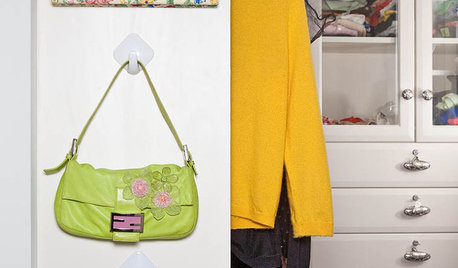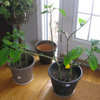Best Solution for Spider Mites
So my babies (ie. two unnamed brug plants) have spider mites, which I understand to be pretty much a commonplace thing during summer, but this is my first year and I'm really protective over my plants. The plants themselves are one year old cuttings that had been donated to me earlier in the spring. The plants were infested at first with whitefly and aphids, as the previous owner didn't really seem them as an issue and let it get massively out of control. I quelled that problem with safer soap and strong sprays of water from the hose. After I moved them out they have more than trippled in size. I MG them weakly every few days and dump bone meal in at monthly intervals. So far this year they are about three feet tall and two feet wide. Both have flowers or buds developing and plently of new "Y"s. They're doing great but I can tell that the leaves have mites. I even IDed them with my handlens so I know for sure. None of the leaves have more than a few mites though, nothing in too dire need. I've been spraying them off with water several times a day and it has helped a bit, but can anyone recommed something to get rid of them completely without making my plants drop all their leaves and buds? Is it really that serious of an issue, or will they go away once it starts to cool down again? Anything I can plant nearby (herb or vine wise) that deter mites? Any help appreciated.
Peace,
Nate
Comments (13)
rain1950
17 years agolast modified: 9 years agoHomemade Insecticides [from various Web sites]
Lime Spray
Target insects: Cucumber beetles, mites and general purpose.
To make: Mix 1 ounce of hydrated lime, 32 ounces of water and 1 teaspoon of castille soap. Use up to twice a week.Orange Peel Spray
Oranges and other citrus fruit contain natural ocurring pesticide compounds called limonene and linalool. These compounds can be used as a treatment for soft bodied pests such as aphids, fungus gnats, mealy bugs and as an ant repellant.
To Make: Pour 2 cups of boiling water over peelings of one orange. Let this steep for about 24 hours. Strain the mixture into a glass jar and toss the peels into the compost. Use this liquid as a spray mixing in a few drops of castille soap on target insects or on ants and their nests. Smells nice too!Pepper and Herb Dusts
Target Insects: General
Peppers and certain herbs contain the compound "capasaicin" which will irritate and repel many insects. Cayenne, chili, dill, paprika, red and black peppers can be used as dusts. Purchase the cheapest you can find (or grow hot peppers and dill in your garden. Dry them and pulverize them in a food processor). Sprinkle on moist plant foliage and the surrounding soil.Pepper Spray
Target insects: All‑purpose
Just like the pepper dusts a spray made from hot peppers will release the capasaicin compound to repel insects.
NOTE: To make: Mix 1/2 cup of finely chopped or ground hot peppers with 1 pint of water. Let this sit for 24 hours. Use as is for a soil drench application or strain the mixture through cheesecloth until you have a clear liquid. Add a few drops of castille soap and use as a foliar application. Keep away from your eyes and skin when using.Tomato or Potato Leaf Spray
Target insects: Repels asparagus beetles and flea beetles.This will kill earworms and maggots and acts as an antifeedent for other insects.
Plants belonging to the nightshade family (tomatoes, potatoes etc.) have large amounts of compounds called "alkaloids" in their leaves. These compounds are water soluble and can be extracted by soaking chopped leaves then using as a spray. The toxicity of the alkaloids may account for only part of their effectiveness. The sprays may also attract beneficial insects that follow the chemicals in these plants as a cue in searching for their prey.
To make: Soak 2 cups of chopped tomato leaves in 1 pint of water overnight. Strain this mixture then add another pint of water and 1/4 teaspoon of castille soap a sticker. Spray foliage and soil as needed.----------------------------------------------------------------------------------------------------------------------
Spray your plants before bringing them indoors!Plants brought indoors in the fall may harbor insects and pass them on to your other house plants. Here's a suggestion for a homemade insecticide:
Put 3 tablespoons of rubbing alcohol in a quart spray bottle, and fill with barely lukewarm water. Add 1 teaspoon of insecticidal soap (e.g., Safer's) or liquid detergent. Spray plant thoroughly, including top and underside of leaves. Let spray sit a few minutes, then rinse. (Leaving the spray on longer may cause injury to the plant.)"----------------------------------------------------------------------------------------------------------------------
Homemade insecticide information and recipes
Description:A few homemade insecticides and repellent recipes.
[from http://mama.essortment.com/homemadeinsecti_rvxg.htm]Although prevention is in the beginning of insect control (companion planting, cleanliness, healthy and disease-resistant plants), insecticides can come in handy at some points. With that in mind I developed this short guide to insecticides to help you choose the one which is best for you, but at the same time remembering the toxic nature of some insecticides. So this guide progresses from the less toxic, homemade insecticides (which can be very beneficial with small or beginning infestations) to the more powerful pyrethrum and insecticidal soaps.
Many of the homemade pest repellent mixtures can be very effective against garden pests. Strong hot tastes or smelly odors are common characteristics of most home‑brewed pest repellents. Most sprays are just repellent plants (plants that repel insects while growing) blended with water and strained through cheesecloth or nylon mesh, leaving a basic repellent tea. The tea is then diluted in water to concoct a spray. The sprays are not usually cooked due to the fact that heat generally destroys the active ingredients. Instead the repellent plant is dried and minced, and allowed to soak in mineral oil for a couple of days. This is then added to water including a little detergent or soap to suspend the oil on top the water, and a teaspoon of alcohol per quart to help dissolve the soap.
There are hundreds, maybe even thousands of good homemade insect repellent recipes that you can find in books and on the internet. The following are a few I have found work best in my garden:
1) Combine one teaspoon of hot pepper or tabasco sauce, 4 cloves of garlic and a quart of water. Blend well in a blender and strain, with cheesecloth or nylon mesh before placing in your sprayer. This will repel many insects including whiteflies, apids, spidermites and caterpillars.
2) Mix 1/8‑1/4 cup of hydrated lime with one quart of water. This creates an effective spray against many insects, especially spidermites. Add a drop of non‑detergent soap to act as a sticking agent and insecticide. Lime can cause serious harm to plants if you use too much, so always spray a test plant first and watch it for a few days, to check for any adverse effects on plants.
3) Take one ounce of tomato leaves and add to one quart of water and blend thoroughly. Strain the resulting liquid and use to repel insects. This works well on white cabbage butterflies too.
4) Take a copious amount (as many as you can collect) of the insect you wish to repel and grind their corpses up into a powder. Mix the resulting powder with one quart of water and, spray as a repellent for the insect that you ground up for the powder.
Insecticidal soaps are mild, contact insecticides that are made from the fatty acids of animals and plants. These insecticides are safe for humans, as well as bees and animals. The soaps will help to control soft‑bodied insects such as spidermites, thrips, mealybugs, whiteflies and aphids. Insecticidal soaps penetrate and clog their bodies' membranes, thereby killing them. You can buy a commercial soap product, such as Safer's Inecticidal Soap, or make your own insecticidal soaps which can prove very effective against your garden pests.
You should use a soft soap (do not use detergent soaps because these can be problematic to your plants' health) such as Ivory liquid dish soap, Murphy's Oil soap, or Castille soap, all of which are biodegradable and can kill insects in a similar fashion to commercially manufactured brands. Mix three capfuls of any of these soft soaps with one quart of water for a very effective insecticidal soap. These soft soaps will only last about a day before they dissipate, and need to be reapplied after above-ground watering or rain.
Nicotine can be a very effective method of pest control as well. It is naturally derived; however, it is not usually used in organic gardens due to its toxicity. Nicotine can be deadly to most insects (and humans when swallowed in concentrate). This poisonous compound affects the neuromuscular system causing insects to go into convulsions and die. Sometimes you can see it sold commercially, mixed with sulfur. One commonly used product is Black Flag's Nicotine Sulfate.
Nicotine sulfate (tobacco/water tea combined with sulfur) is excellent for use on all plants except members of the nightshade family (potatoes, eggplants, peppers, tomatoes). To make your own tobacco spray: simply combine 1/2 ounce of tobacco per quart of water, soak for one day at room temperature and strain the resultant tea. Nicotine sprays are useful on all insects, but are usually used for aphids. It is not recommended to use nicotine sulfate on plants you intend to use for consumption.
Horticultural oils are a non‑poisonous, safe, and non‑polluting insecticides. They are usually used to kill slow-moving or immobile sucking insects by suffocating them with a thin layer of oily film. These types of insecticides are usually produced by manufacturers and not concocted by gardeners themselves. Horticultural oil spray can be useful against many bugs including aphids, scales, thrips, spidermites, whiteflies and mealybugs.
Pyrethrum is . . . by far the most effective and most-used of the insecticides. It is extracted from the flowers of the pyrethrum chrysanthemum. Seeing as how the main ingredient in pyrethrum comes from Africa, it is hard to make at home and can be found commercially sold at retail nurseries (there are many types available so I will not mention any brand names). Being an insecticide with a wide array of uses, pyrethrum is very toxic to most insects, even those that are beneficial. When applied as a spray it can also be useful against flying insects. If the insect doesn't receive a large enough quantity, it may revive, so pyrethrum is usually combined with rotenone or ryania to ensure effectiveness. Pyrethrum should be used to spot spray only heavily infested plants. It is non‑toxic to animals and humans and is very effective when applied to your garden manually.
Most insecticides are usually available because they have some usefulness, but do not take this as a sign that they are all the same or even effective. Some homemade sprays can be just as effective as the most powerful commercial insecticides and [are], in most cases, less toxic. Always review all your choices before choosing a product and choose which will be better to use considering your garden size, pest problem and size of the infestation.
Copyright 2001 by PageWise, Inc.
--------------------------------------------------------------------------------------------------------------------
Homemade insecticideWould you like to control pests in your yard and garden without using harsh, dangerous chemicals? You can, and you may be surprised at how safe and easy it is.
Ants, fleas and many other types of bugs are repelled by a human‑safe concoction of soap flakes and water. This mixture may be sprayed anywhere in your yard, in your flower beds, and even in your vegetable garden.
This simple soap flake/water mixture will drastically reduce the pest population around your home. Using a box of mild soap flakes, mix a cup of soap with a couple of cups of plain water, and pour the `soup' into a sprayer. Next, spray your yard the same way you would if you were spraying it with chemicals. The soap is non‑toxic, dissipates quickly, and leaves no harmful chemical residue on your lawn. Fleas, ants and other annoying bugs will be driven away.
You may also use this mixture on your flower beds and gardens. It will not harm your delicate flowers, nor will you have to scrub dangerous pesticides off your fresh fruits and vegetables. Try spraying the soap mixture directly onto the garden plants to effectively repel bugs, worms and aphids.
If you have a problem with ant beds in your yard, you may find it helpful to mix up a stronger concentrate and pour it directly onto the mound. You can even pour the dry soap flakes onto the hill. The ants will quickly start to scatter and many will die immediately from contact with the soap. If ants have been coming into your home, find the outside source and treat it with the soap mixture. You may also find that sprinkling soap flakes thickly around the base of your house will help repel insects.
Should the pests come back, repeat the treatments as needed. The soap will not harm your grass or shrubbery, and there will be no harsh chemical buildup to worry about. You may also use a mixture of liquid dish detergent and water instead of soap flakes.
Copyright 2001 by PageWise, Inc http://www.allsands.com/Gardening/homemadeinsecti_ycu_gn.htmkaryn1
17 years agolast modified: 9 years agoI won't use insecticides and have no problem controlling spider mites with just plain water. I hose the plants down with a fairly strong spray of water all over, paying special attention to the undersides of the foliage. I do this a couple times a day until I don't see anymore bugs. I hose all my plants down periodically as a preventitive measure. I usually don't have mite problems when the plants are outside. It's when I'm wintering them over indoors that I have problems.
KarynPlanterRic
17 years agolast modified: 9 years agoIdeally, misting with plain water twice a day for three days would work because spider mites have a three-day life cycle. However, I've tried it, along with every other organic solution I can find -- though some of the mixtures suggested by rain1950 are new to me. I can assure you that insecticidal soaps and dish soaps are ineffective, and strong grease-cutting soaps like Dawn can really damage your plants.
If you want to get rid of spider mites, buy Orthenex which is the new generation of Rose Pride by Ortho (the label says both Orthenex and Rose Pride). You can find it in most garden departments. The active ingredient is acephate. Mix it with water according to the instructions and spray tops and bottoms of leaves. The plant absorbs it (as a systemic pesticide) and it will get rid of spider mites, mealy bugs and scale, among other pests.
I would love to stay organic, but it just doesn't work.
lola1
17 years agolast modified: 9 years agoI haven't posted in a long while, but admittedly, this is a subject that is unfortunately dear to my heart.
For a couple years now I have gotten hit pretty hard with mites. Like real hard. Hard to a point where ALL the leaves turn yellow and fall off. Not all at once but within a matter of 1 week I've had brugs and other perennials like honeysuckle go from being lush and green to yellow, spindly and sick.
Here in central CA it can happen and happen fast. This year I vowed to stay on top of things. I sprayed neem every 5 days. I sprayed Bt once a week to prevent worms. I was so pleased that again this summer that a good 'crop' of praying mantis were out and about enjoying their feasts. ---I realize the mantis's actually do not prey on mites - but I'm pleased that their presence along with the lacewings are the healthy by-product of an 'organic' approach.
Well, given that technically neem shouldn't be used in direct sunlight and/or in temps above 80, that was literally impossible to uphold seeing that our low nighttime temps recently have not been below 90.
So, in an effort to squelch the mites, I sprayed neem as late (or early) as possible and now I'm afraid I could have lost 2 brugs. Both have lost every leaf and they're turning brown at the tips. This is horrible!
I want to say that neem and other organic measures are the way to go, also, but I'm afraid that in some cases of extreme or sustained dry heat, it just doesn't work. I've tried the spraying water thing, too. Getting a water ticket is not a good option.
I have now ordered Avid which is a miticide that apparently is very, very popular on the Rose forums. It's not cheap, but I'm literally desperate. It's supposed to have very low phytotoxicity and it does not hurt beneficials. This really is important to me, hence probably why I've continued to try for so long without succumbing to more toxic methods. I'm going to see how the Avid works.
Mites here in central CA are the bain of my gardening experience!
gardengrove_ac
Original Author17 years agolast modified: 9 years agoThanks for all the useful information. I think I'm going to hold off on pesticides (But if I do, I'll remember Avid and Orthenex) and try to just intensify the hose spraying. Its odd though because one of the plants doesn't really seem too infested, while the other has leaves turning yellow all over the place. Could there be a difference in how easily some strains get certain bugs? If I were to spray, would either of the prior mentioned pesticides cause a leaf or bud drop? I'm definitely gonna have to pick one of them before I move the plants into the greenhouse this fall or they're going to be looking pretty ragged.
Thanks,
Nathanmellen_grower
17 years agolast modified: 9 years agolooking for the mix ratio for the oil water treatment through a garden sprayer for the hose can anyone help?
beachplant
17 years agolast modified: 9 years agoHeck, I live in mite central. If they don't have millions of snails, aphids, spider mites, leaf miners, caterpillars or something else chewing on them I think they are dead. Haven't lost a single plant to the pests in all the years I've been gardening. I just don't have the time to spray everything.
Get beneficial insects. Since I don't spray my yard is full of lacewings, assassain bugs, lizards, birds, wasps, toads, lady bugs and other stuff that eat pests. So we have a happy balance. WEll, mostly, sometimes the white flies get out of hand on the confederate rose or I get mealy bugs on the cactus. I then spot treat. Yellow boards covered w/ oil for the whitefly and alcohol for the mealy bugs.
Good luck with them.
TallyHO!rite2u
17 years agolast modified: 9 years agoI started to see signs of mites as well as aphids and got my neem mixed with ivory soap spray and gave my peaches and cream a good soaking last weekend...
I looked yesterday and found this guy and a dozen of his buddies munching on the underside of the leaves..I don't know what he is, but he's probably beneficial...
{{gwi:517939}}
{{gwi:517940}}
By the way, he's not shown on a brug leaf in those pix. He is on a hyacinth vine leaf that is next to the peaches and cream.Then I saw this lady bug on a Datura just a few feet away so now I'm hopeful that my insect friends will take care of the problem.
{{gwi:517941}}rite2u
17 years agolast modified: 9 years agoI posted on the insects forum and got an answer about these bugs. The two on the top are the lady bug (lady beetle) larva. My army of garden helpers have arrived to take care of the mites, aphids and everything else...Let nature take care of it!
karmahappytoes
17 years agolast modified: 9 years agorite2u, how sad to see them with this many problems. The goal is to keep them health; virus and insect free.
smurfboy
17 years agolast modified: 9 years agoI never have trouble with anything outside on my brugs except caterpillars chewing leaves, I do get whiteflies and aphids after I bring them in for the winter, but only when I bring them in.

















BradtheBugMan